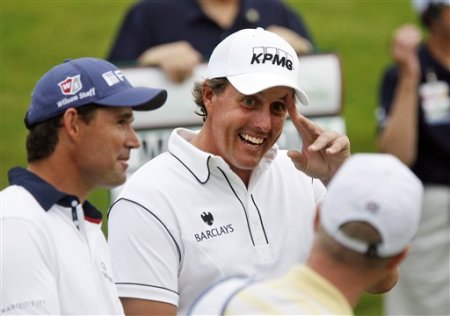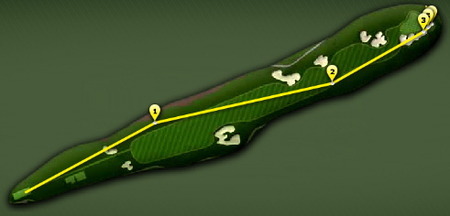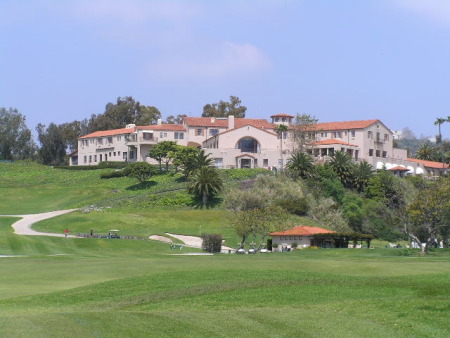Harrington looks to Finchem for Ping solution

The Dubliner tested the clubs (which he picked up from Headfort professional Brendan McGovern) at the LA venue on Monday and explained that they appeared to give aggressive wedge players significantly more spin than the traditional V-grooves.
Confessing that he was in two minds over what to do, Harrington said: "Whether I'm going to use them or not, I'm kind of waiting to see what the TOUR's direction is this afternoon. What I'm doing is I'm preparing myself for all eventualities. It would be naïve not to.
"I did some good testing yesterday. Unfortunately the testing showed up exactly what you would expect, and there's a significant difference. I think that significant difference depends on the players. Some players don't find that there was a difference between the old V-groove and box groove.
"Other players find that there is a big difference. I think they'll find that some players don't feel it's necessary in their game. Other players who are probably a little bit more aggressive do feel like this is something that they need, and the groove change necessarily is not helping their game, let's say.
"As regards what I feel about whether it's right or not, I don't know what the direct comments were by Scott McCarron, but I think most of us were brought up that you've got to adhere strictly by the rules, and whatever those rules are in place, you've got to play by them.
"We've all played in our career where we've hit it on the cart path and got a drop, and that drop has been substantially to our advantage, and that's the nature of the game. Other times you get a drop and it's -- the rules are substantially against you.
"You know, it swings around about in that sense, that you can't -- you have to play exactly by them. You can't necessarily -- the interpretation of them, that leads to problems and has led to problems over the years, so that's why we stick by it."
During last week's Farmers Insurance Open at Torrey Pines, Phil Mickelson used 20-year-old Ping Eye2 square-groove wedges that are legal according to the USGA but non-conforming based on the new rule regarding the dimensions of grooves on irons.
But Harrington would like clarification from the PGA Tour and hopes a solution can be found to an issue that has dominated the US season since players started using the Ping wedges in Hawaii three weeks ago.
Harrington said:"I would like to see a clarification myself. I would like to see a situation. Legally I don't know how they can go about it, but maybe the PGA TOUR could play under the rules of the R&A, then we'd have no problem. Maybe Ping could forego the lawsuit, then there would be no problem. Or possibly, I don't know, this is what I would sort of suggest, is that maybe everybody sign up to a charter and say we won't use them. But while they're out there being used, it's a difficult situation not to -- for anybody who's competitive not to go out there and take full advantage of what you can if somebody else is.
"It's an interesting one. I did the testing and still, every ten minutes, it's in the bag, it's out of the bag. That's basically how it's been going. I haven't settled at all on what I'm going to do, but I'll have to. It could be ten minutes before my tee time and not know what I'm going to do this week.
"As I said, I'm hoping for some good clarification this afternoon from Tim Finchem. I'm hoping something comes out of that that makes the decision and takes the decision out of my hands, really."
Harrington revealed that he has been using a 60 degree lob wedge he picked up from McGovern after he sold his seven Ping wedges at a charity sale in aid of GOAL shortly before Christmas.

Asked if he got it on eBay, he said: "No, a professional golfer friend at home Brendan McGovern. When they changed this rule at home at the end of last season, I looked at all the golf clubs that I've built up over the years, and I sold them all. I sold them all for charity just before Christmas, cleared out everything I had. Then I find out amongst the clubs I sold were seven Ping wedges. And then I find out four weeks later at Hawai'i that you can use those clubs.
"So I then had to go ask a couple of people did they have any. And I got some from my caddie's mother, she had Ping wedges, a Ping set; and I got some from Brandon McGovern. As I said, the lob wedge, some of them were too late, some were too early, but the lob wedge is within the time frame. And the grooves are reasonable without being absolutely brand new or anything.
"It's amazing... I must have had them for 20 years, and I said I'm getting rid of everything, and I had a total clean-out, and sure enough, you need them next week."
The Dubliner reckons the Ping wedge gives him an extra 200 rpm's more out of the light rough and the heavy rough with short and long shots but that there was no difference with regard to his Wilson wedge when hitting from the fairway.
The key to the matter is distance control from the rough, he said, and the Ping wedge made a significant difference in that regard.
"I played a Ping lob wedge for a number of years in my amateur game, so it's not an issue for me or a problem for me at all in that sense," Harrington said, adding that a player's angle of attack was a vital factor in the whole affair.
"[Angle of attack] It has a huge difference the way a player swings a golf club. Obviously the narrower he is on the way down and the steeper he is, the less need he has for super sharp grooves. But we could have had this discussion for the last number of years, because many times over the last number of years, the comment about box grooves or sharp grooves would be built up, and there would be a significant number of professional golfers who said it makes no difference to their game.
"To me like the difference between a box groove 7-iron and a V-groove 7-iron, at least not getting a flier, is 30 yards in distance. I could explain that to a lot of professionals and they'd look at me as if I had two heads.
"That's why I've carry two sets of golf clubs for the last six, seven years, to make sure I always have the right grooves for the right grass.
"But it makes a significant difference. But then, as I said, there are players who generally don't miss too many fairways and don't miss too many greens, and you know, and other players who are steep that it doesn't have such an effect.
"But if you're aggressive and you're going at par-5s maybe when you should be laying up and things like that, it certainly takes the aggressive club out of your hand. You can't afford to miss those par-5s coming up short with a -- if you miss the green 15 yards off the bunker, maybe you've got 35 yards to the flag, that's where you're in trouble now. Not necessarily those five-, ten-yard shots.

"As I said, those guys who have already played that way are all in favor of the -- were in favor of the change, and other guys who are a bit more aggressive certainly would like to have what they used to have."
Putting the matter of integrity aside, Harrington agreed that the rule change on grooves was fascinating but also insisted that the governing bodies had taken the easy route in targeting grooves instead of long putters, for example.
You've got to think that the rule was changed because it was a soft one to change. Nobody could come out and say, oh, no, we don't want the players -- we don't want any advantage given to a player that's hit it in the rough and we want the guy who hits it straight -- it was a very easy rule change to make. It would have been a lot harder rule change to go and say, well, we're going to ban long putters because then you would have had people coming out and saying no.
"But there was very dissenting views, very few people who had a dissenting view, and certainly a dissenting view publicly to the groove change. But it is a significant change to a lot of people. I know I've been testing during the winter, and it's quite significant.
"You know, I'm surprised that -- I don't know, when did it first come up that this was going to happen? I only heard it in Hawai'i, as I said. I finished up last year selling them off thinking that was the end of those clubs. It does seem like we should have been prepared for this. Who had this idea first? I'd love to know who was the person. Did they know six months ago that there was going to be an issue with these box groove clubs?"
Told that the Ping clubs had been cleared as conforming in August 2008, Harrington said: "It wasn't announced to me.
"It's interesting. Because of the fact, because of the way we govern ourselves when we play golf, we strenuously stick to the rules. You have to. That is the whole idea is that you have to stick to the rules. It has to be black and white, it really does, and the problem here is that it is black and white, that it's legal. So that means there has to be something else done about it. What can be done, because it was a Supreme Court ruling, wasn't it? Is it Supreme Court? It's not like the PGA TOUR, you know, who do we think we are if we can overrule the Supreme Court.
"It's not like that. We have to go some other way. I'm not sure what that is. But a charter amongst the players would seem like a logical thing, if everybody signs up and says, look, we won't do it, then I don't think anybody would do it."





